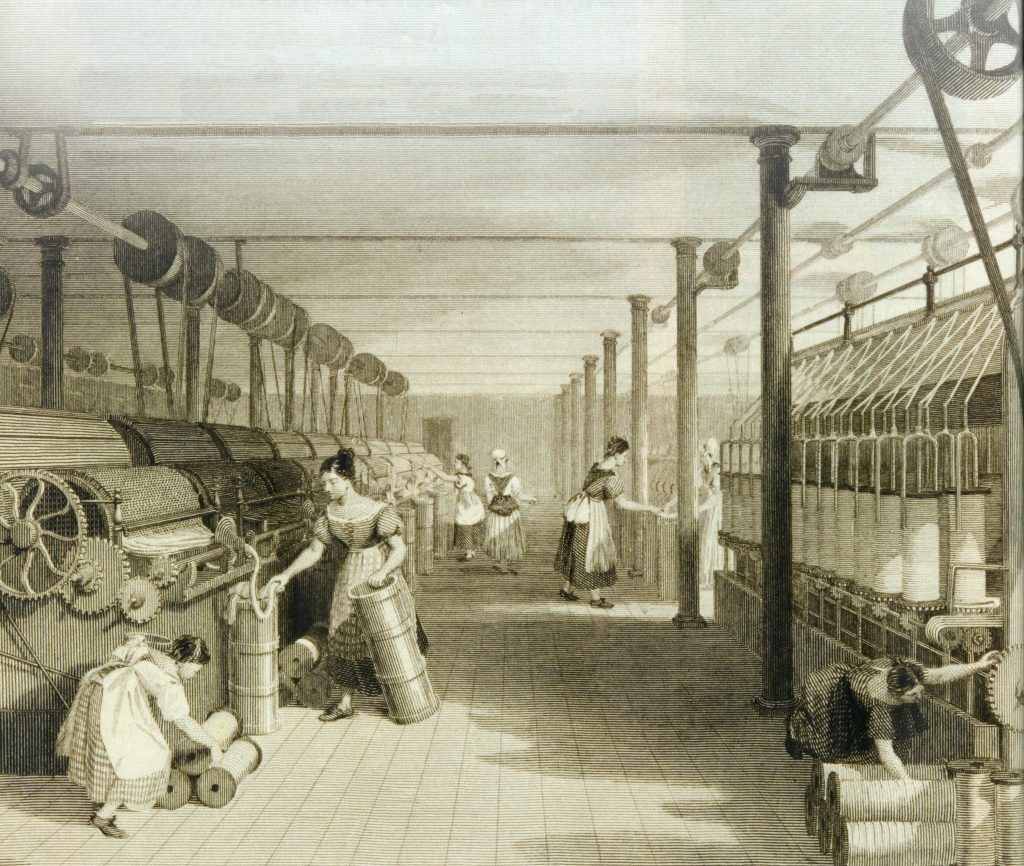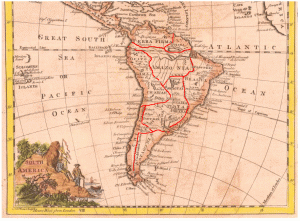Children today spend five days a week going to school for eight hours. During the first half of the nineteenth century in Britain, this was not the case. Instead, children even as young as five or six would toil all day long in factories or in mines. They had no breaks, no time off, and no schooling. Their work often led to horrible accidents, children being injured for life, and children left without an education.
Children laboring, of course, did not start with the British Industrial Revolution. It had been a normal part of life in Europe since the middle ages, when children helped their parents on farms and with household work. The people’s perception of this work, however, changed during the Industrial Revolution, since that is when people began to see this new kind of labor, factory labor, as an injustice and even criminal.1
The Industrial Revolution began in Britain during the 1780’s and rapidly changed the work process and the social relations of work. Prior to the Industrial Revolution, most people worked directly in the production of food, usually as farmers on their own farms. When textile factories began forming in the new factory cities, instead of working on their farms and making what their family needed, people left their farms and moved into the factory cities to make a living. Factory conditions of work, however, were far different from the work rhythms of farm life. In fact, they were brutal in comparison. Factory workers would typically put in between 12 and 16 hour days, working for meager wages. The machines they attended were dangerous, and the workers were often on their feet throughout the day, with perhaps a half-hour break for meals. Among these workers were children, many of whom were as young as five or six years old. Children were valued as workers for their small stature and ability to climb into small places and do things that adults often could not do. This often resulted in mutilation and the loss of appendages for many of these children.2
Children were also valued as workers by the factory owners because of the low wages that they were paid. Men were paid the most in factories, followed by women and then children. These wages, however small, were needed by the families of these children simply to survive. The parents often sent their children out to work to help pay for rent, food, and otherwise help make ends meet.3
One reason that the British public became outraged by child labor practices was the fact that children in factories were not receiving an education. Horace Mann, an American educational reformer, stated:
No greater calamity can befall us as a nation than that our children should grow up without knowledge and cultivation. If we do not prepare them to become good citizens, develop their capacities, enrich their minds with knowledge, imbue their hearts with a love of truth and all things holy, then our republic must go down to destruction as others have gone before it.4
This represents the thoughts of the British at the time, which was being echoed in the United States during its own industrial revolution. People wanted to ensure the future of their nation, which starts with the young. They believed that children should attend school for at least a while.5 This led to several laws being passed to raise the legal age of work.
In 1833, the British Parliament passed the Regulation of Child Labor law to help improve the working conditions for children in factories. The Law limited the age of workers, saying that they had to be older than nine with an age certificate to prove it, and that children 9-13 could not work for more than nine hours a day. Additionally, children 13-18 were not permitted to work longer than twelve hours a day. Along with these work-hour restrictions, the law also made school attendance a two-hour requirement, and said that children could not work at night. Fines for breaking these rules were small, however, so they were frequently violated, often with impunity.6

Many other pieces of legislation were also passed to place limits on the gender, hours, and ages of workers. The Mining Act of 1842 prevented women and girls from working in mines, and the Ten Hours Bill of 1847 set ten as the maximum number of daily working hours for women and children. This act was hated by factory owners because they believed it would hurt the textile industry’s competitiveness worldwide. After these bills, others followed to ensure their effectiveness, and to ensure that they would be properly implemented.7
By 1900, the minimum working age had been raised to twelve years of age and child labor had decreased drastically in Great Britain. However, the introduction of legislation against child labor provoked its share of protests as well. Because of these protests, Parliament established commissions to collect evidence of abusive practices. These were called the Blue Books or Sadler Reports. They interviewed children, parents, factory workers, owners, and even doctors on the condition of children in textile factories. Unsurprisingly, the reports uncovered a range of serious abuses by factory owners and overseers. Unfortunately, most critics just said that the claims were exaggerated in order to continue their money making practices.8
The legislation surrounding the British Industrial Revolution had become very effective by 1900, and child labor and its accompanying abuses had decreased dramatically. By 1900, most children were attending school instead of working in factories. The laws passed finally added up to changing British child labor to being closer to what we see today, a mostly child-free labor system, with children going to school and adults having regulated working hours.
- World History Encyclopedia, 2011, s.v. “Child Labor and Child Labor Laws in Early Industrial Great Britain.” ↵
- James D. Schmidt, “Broken Promises: Child Labor and Industrial Violence,” Insights on Law & Society, no. 3 (Spring 2010): 14–17. ↵
- Robert Whaples, “Hard at Work in Factories and Mines: The Economics of Child Labor during the British Industrial Revolution,” Business History Review, no. 2 (2001): 429. ↵
- Friends’ Intelligencer vol. 28 no. 1 (1871): 336. ↵
- James D. Schmidt, “Broken Promises: Child Labor and Industrial Violence,” Insights on Law & Society, no. 3 (Spring 2010), 14–17. ↵
- Great Britain, “Factories Regulation Act” (1833). ↵
- Steven Toms and Alice Shepherd, “Creative Accounting in the British Industrial Revolution: Cotton Manufacturers and the ‘Ten Hours’ Movement,” MPRA Paper, No. 51478 (2013), 6-8. ↵
- World History Encyclopedia, 2011, s.v. “Child Labor and Child Labor Laws in Early Industrial Great Britain.” ↵



141 comments
Luke Rodriguez
Very informative article from the very start. It was fascinating that little kids did not go to school, but they worked because of the Industrial Revolution. Many of those children that worked would get injuries that would affect them for life and even risk their young lives just so the family could get some money. However, times were completely different then compared to now.
Kristen Leary
Great article! It seems like things like going to school for 12 years is so natural, but maybe that’s something we take for granted in America these days. It’s hard to imagine living in a time and society where children so young spent their days working to help support their families. Children so young, that laws had to state you had to be 9 years old to work, which is still so incredibly young. Very informative article, and very well written.
Jacob Adams
I’ve read a couple of articles about the industrial revolution at this point and man was it rough. I mean cmon, the children too? However, their small bodies and small fingers make them perfect for the job. That doesn’t make it ok obviously… I mean at least pay these little kids fair wages! I think school was the best choice for them at the time. These kids cant learn inside a factory! THIS ARTICLE HAD GREAT PHOTOS AND SOURCES, that kept me engaged through out the reading.
Adelina Wueste
This article was very informative and very well organized. It’s crazy to think that children as young as 5 had to work 12–16-hour days to support their families. Another aspect of the article that is very interesting is that children were more sought after in the factories, yet they got paid the least. It’s sad how the child labor law was passed yet the law still permitted for some children to work up to 12-hour days. It’s even more sad to think that even though there were rules in place that supported the bare minimum protection for child workers, the laws were still ignored.
Sofia Perez
Amazing Article! I have learned about the American Industrial Revolution, but not the British Industrial Revolution. Many children worked in factories rather than going to school just to go help their families make ends meet and pay for necessities. I was astonished to read that once child labor laws became apparent, factories would still violate them due to the small fee they had to pay.
Hailey Koch
Great article, I really enjoyed reading it and learning lots of new things. It’s crazy to think that in the 19th century, kids’ lives were so different than they are today. Then they didn’t care about education or how old a child was as they would be working none stop without any breaks. Now children are required to go to school as soon as they become of age and they have to be in school until they graduate high school then it becomes their choice on what they do next. I also find it crazy that during their factory work, their families relied on their work for income to keep the family moving. To put that on children is so crazy to think about especially for the fact that in today’s world pressure isn’t put on kids when they are very young, especially with the age requirement on working somewhere.
Jaedon E
Very informational article. Awesome use of describing the difference between the lifestyle from farming to working in the city. I believe many people back then believed that working in the city would be much easier. But not only the men working long hours, women and children endured the same servitude. I couldn’t imagine what life would be like if those Child Labor laws were not established. Although I am grateful for being able to get an education first, and have much knowledge before wanting to start working in the world.
Great article of choice!!
Lauren Deleon
You did a very good job of describing the horrible conditions that English children were faced with in this system. When I think of British child labor, one particular story comes to mind, is the story of the matchstick girls who went on strike against 14 hour work days and conditions that were killing them. I cant quite remember for sure but I think that there was some type of chemical in the matches that was making them very sick. Your article explains the context of these types of stories very well and I learned a lot from reading it!
Priscilla Leal
interesting article! i really liked the structure of this article. its interesting to see the evolution of a child as young as 5 working under harsh conditions to passing laws that required them to attend school and therefore decline child labor. Not only were children helped under these new laws but women as well. education should be a priority for all.
Nicholas Quintero
this was an amazing article! I enjoyed that how the paragraphs were broken and how information was presented. it was easy to follow along, especially since the story and progression of child labor and how it evolved and regressed during this time period.